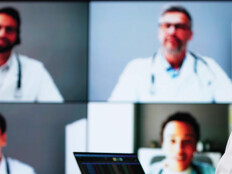The technology was designed for underdeveloped countries and nonprofits to improve healthcare delivery and aid in identification efforts. Having fingerprints on file makes it easier to maintain consistent care, check for allergies and even reunite children with their families.
Trials in Mexico and Africa have proved that the device works, and Spencer says it could be available to commercial hospitals within two years. The UC San Diego team plans to incorporate more features to measure temperature, blood pressure and other vital signs.
Iris and Facial Recognition Technology Improve Workflow
Laura Semlies, vice president of digital patient experience for Northwell Health in Melville, N.Y., helped integrate iris and facial recognition technology into the Northwell system in 2018. The goal: to improve workflow, reduce duplicate medical records and ultimately help patients feel known throughout the health system. “People are used to checking in at a kiosk at the airport, but in a medical setting, we’re working to make the process feel more personal,” says Semlies.
To the patient, enrollment feels like getting an ID photo taken. The software is able to record biometric data from both the face and eyes, which Semlies says is critical.
“The best users of biometrics don’t use just a single biometric, so that’s why we chose iris plus facial identification,” she says. “We want to make sure we’re treating the right person and can verify it’s them.”
So far, about 50,000 patients have participated. Although that’s a fraction of the more than 5 million patients Northwell serves annually, Semlies anticipates wider buy-in and expansion into new areas, including voice recognition as an added layer of identification.
LEARN MORE: Two-factor authentication gains steam for prescriptions, patients and clinicians.
Fingerprint Scanners Help to Enhance Patient Security
At the University of Pittsburgh Medical Center, the IT department first implemented fingerprint scanners in 2016 to reduce patient registration times for office visits. The system also is intended to reduce fraud.
Today, UPMC operates nearly 3,800 biometric readers across 68 sites. Users have been receptive, says Ed McCallister, the organization’s CIO.
“The vast majority of patients are eager to use their fingerprint to check in to their appointments, for both convenience and security reasons,” says McCallister. The technology, he adds, “is an excellent example of how we are aiming to make the consumer experience more personalized, coordinated and connected.”









